Winter in Crete – What to do in Crete if you visit during the winter!

Crete has so much to offer the traveller. It is easy to associate this fantastic island with its famous beaches. But in Crete, beaches -as impressive as they may be – are only a part of the story. The things that make Crete such a truly unique destination are just as easy to enjoy in winter as summer – in fact, even better, because you will enjoy them without the high season crowds. Some of the attractions of Crete are ever in winter – such as the famous mountains. And still, other pleasures are unique to the winter months – a secret that really only the locals know. With your rental car in Crete you will be able to experience the diverse landscape of this magical Greek island.
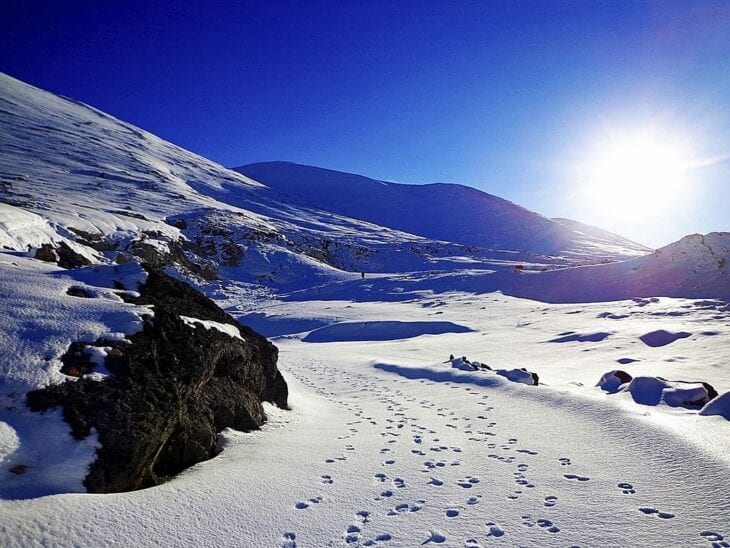
Do you still insist on swimming? Well, then you’re probably in luck. This southernmost island features enough mild days in winter that some consider it suitable for year-round swimming. If you’re from a chillier climate, you might find it downright balmy. So, maybe even swimming too – minus the crowds.
Besides the possibility of a beach day, here are some of our favorite ways to experience winter in Crete.
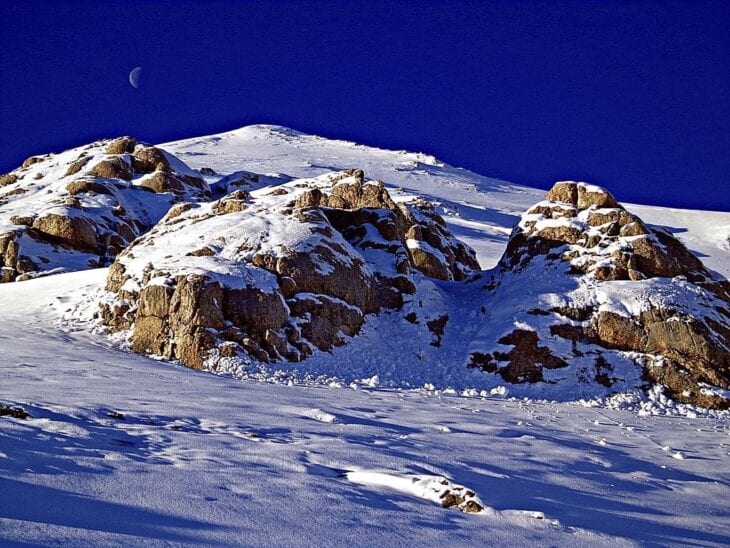
What to do if you visit Crete in the winter
During the off-season, visitors can revel in the island’s lush green landscapes, explore its stunning mountain ranges, visit peaceful monasteries, and enjoy the solitude of its archaeological sites. They can also immerse themselves in traditional village life and explore the island’s rugged gorges. Must-see monasteries include the Arkadi Monastery, Toplou Monastery, and Moni Preveli. If you want to discover more activities in Crete, read below.
Revel in the Green, and More
Visitors to the Aegean in winter are surprised to find a completely different landscape than the one they see depicted during the summer. The intensity of the sun turns the landscape golden and dry in many places. Winter is Crete’s lush season, with a green landscape. And also bare branches – it’s a completely different island look.
This rich soil of Crete is full of surprises. Famous for its wildflowers, the island gets an early start. The winter is full of beautiful and exotic wildflowers. The white paeonia, the Asian buttercup, purple anemone, the tulip ‘Cretica’, and the various types of crocus are among the many wildflowers of winter. The true star of winter though? Wild orchids! Some 60 varieties of orchids flourish on Crete, some of them starting in depths of winter – such as the orphys mesaritica and the and the orchis collina.

The Mountains of Crete
Crete is famous for its mountains. The “Lefka Ori” (the White Mountains), in the western section of the island, are its most prominent range, with the peak of Pachnes at 2453 meters. Mt Ida – also called Mt. Psiloritis – at 2456 meters, is Crete’s tallest mountain. The white mountains are so-called because they are capped with snow well into spring. Mt. Ida, too, is covered with snow usually from December through April. There are refuges for climbers on both mountains.
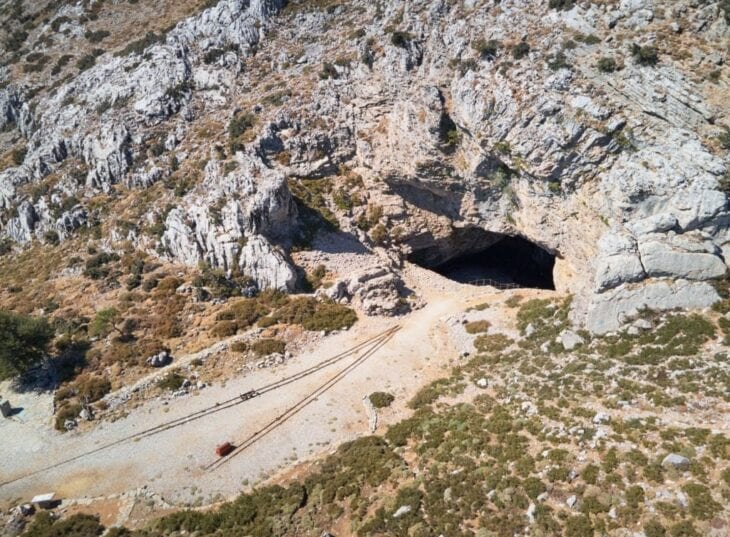
For those who do not climb, the mountains of Crete in winter provide a dramatic backdrop. Mt. Psiloritis has another distinction – the Ideon cave is the supposed place where Rhea hid her son the infant Zeus, to protect him from being devoured by his father, Cronus. (Another Cretan cave – the Diktaion cave in the Lasithi plateau – makes the same claim).
Monasteries
Crete is famous for its many monasteries. Places of religious pilgrimage, the monasteries of Crete are also superb cultural and historic destinations, for a variety of reasons. Exceptional architecture is one reason, the collections of sacred art is another. And did you know that the monks and monasteries have played brave and active roles in the defence of Crete and their fellow Cretans throughout history – not just against the Ottomans but also as recently as in World War II?

Today, as in the past, the monasteries produce wines, “raki”, honey, extra virgin olive oil, and other products, making them interesting destinations for the oenophile and the epicure. Here are some of the most famous monasteries of Crete.
Arkadi Monastery
The Arkadi Monastery, in the Rethymnon prefecture, is thought possibly to date from the 5th century. This walled monastery has an extraordinarily beautiful “Catholicon” – main chapel. It is an ideal example of Cretan Renaissance architecture – uniting both elements of the Renaissance and the Baroque.

This was built when the Venetians ruled Crete. The monastery was known for the excellence of its library, and the Arkadi monastery was a place of learning, of the sciences and art. When the Ottomans invaded the island, the monastery remained Christian and prospered. Finally, in 1866, this place played a brave and tragic role in the history of Crete. In an event known now as the Arkadi Monastery Holocaust. During an uprising against the Ottomans, nearly 1,000 civilians sought shelter here, and finally sacrificed themselves, blowing up the gunpowder room at the strategic moment that the Ottomans took siege.
Toplou Monastery
At the northeastern tip of the island, in the marvelous Lasithi prefecture, is the Toplou Monastery – close to the palm forest of Vai.
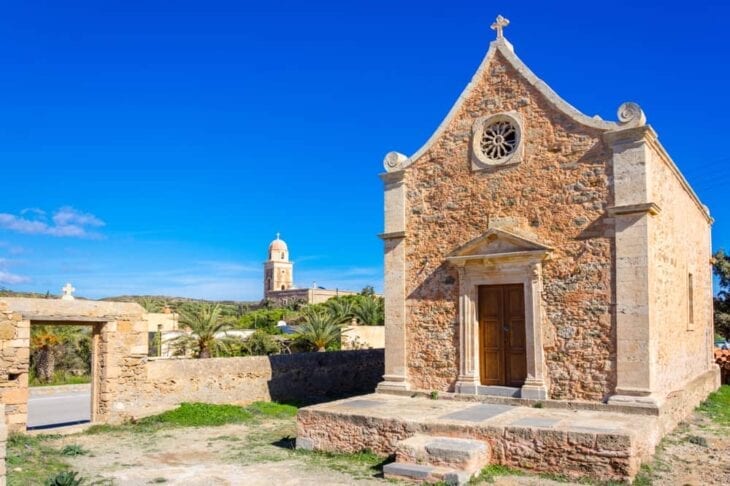
This prime cultural and religious destination has a turbulent history. It is heavily fortified, having been built to withstand the sieges of pirates, with 10 meter high walls. It has been plundered by the Knights of Malta, destroyed by an earthquake, and devastated in the Cretan revolt. Still, it stands proud, a powerful monument to the bold and brave Cretan character.
There is no hint of this violent past today, in this most civilized of cultural destinations. The monastery has a fine selection of Byzantine icons, and well as exceptional portraits of monks, by the famous portraitist Thomas Papadoperakis. The frescoes in the monks’ dining hall – the “trapezaria” – are done by the famous icon painter Manolis Betinakis.

After enjoying the art, you can sit down to a tasting at the winery. The monks are excellent winemakers and distillers, cultivating indigenous grape varieties such as Liatiko in their organic vineyards. Taste their wines with local artisanal cheeses to get a full appreciation of the Cretan terroir.
Moni Preveli
On the south coast of Crete, perched high above the Libyan sea, is one of the most spectacularly located monasteries in Greece. Moni Preveli dates from the late 16th century. It’s famous for the roles it has played in both the Cretan uprising against the Ottomans as well as playing an active part in the Cretan resistance during WWII.
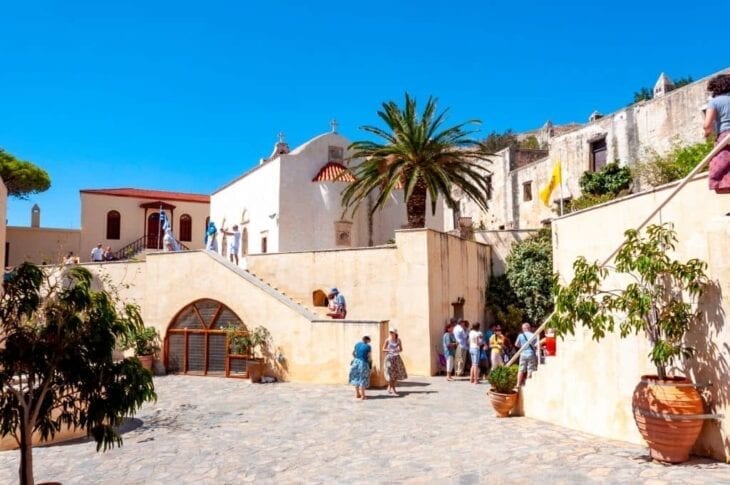
Far below the monastery is the famous Preveli beach. A river whose banks are covered with palms flows through a gorge into the sea. It’s magnificent from above, and well with the lengthy climb down the stairs to get a closer look and wander along the riverbanks among the palms.
Explore the Gorges of Crete
While the famous Samaria Gorge is closed in winter – its high altitude and consequent snow making it impassible – there are many other excellent gorges. Crete is famous for its gorges and has hikes for every level of skill. Winter is an excellent time to explore the coastal gorges, and many find the season less fatiguing, without the hot summer sun blazing overhead.

The Gorge of the Dead in the Lasithi region begins in Ano (“upper”) Zakros and leads to Kato (“lower”) Zakros, on a hike through wonderful scenery. The caves high in the walls of the gorge were the final resting places of the Minoans of the Palace of Zakros – a fascinating excavation that awaits you at the end. This is part of the European E4. You can also start at the bottom, go as far as you wish, and return.
Enjoy the Archaeology in Solitude

Crete is home to some magnificent archaeological sites, among them the world-famous Palace of Knossos. Getting to know Crete’s sophisticated and advanced Bronze-Age society (the first palace of Knossos predates the Parthenon by about 1500 years) is one of the most significant cultural experiences in Crete. Of course, a site of such tremendous importance is very crowded in high season. In winter in Crete, you can wander through Sir Arthur Evans’ evocative excavation, contemplating the myths of the Minoans (Theseus and the Minotaur, for example) in tranquility.

Enjoy Village Life
Crete’s villages are where the true Cretan culture really thrives. Visit mountainous, proud Anogia to hear the finest Lyra playing anywhere. Cretans are famous for the speed and skill of their lyra playing – Cretan traditional music quickens the pulse. Anogia has produced some of the most legendary players of Crete.
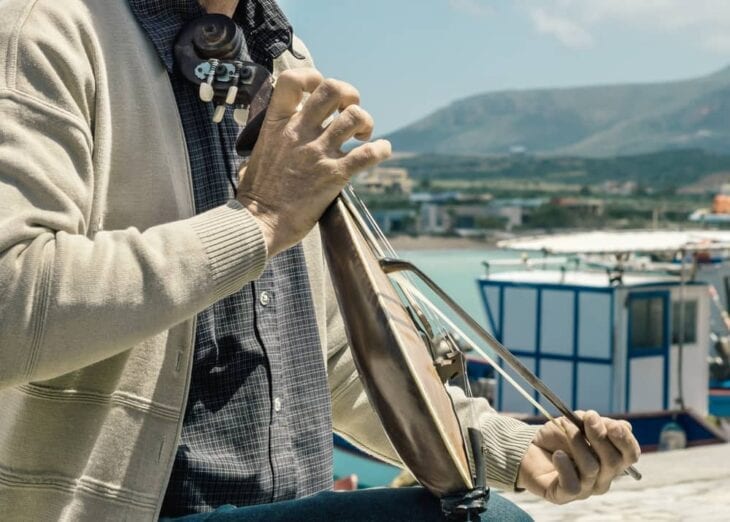
The village of Margarites is famous for its excellence in ceramics, and has been throughout the centuries. You can visit the studios of artisans and shop here for truly unique pieces, including innovative designs from ancient Greece – like the Pythagorean cup.
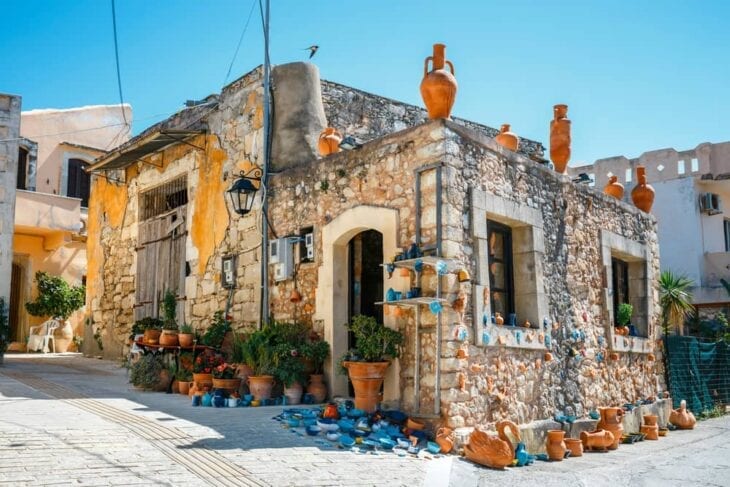
Sfakia, a fine fishing village, is on the south coast of Crete. From here, one can take a ferry for a short ride to Loutro – an enchanting village of blue and white that can only be reached on foot or by sea. Wrapped around its snug harbor, inaccessible by cars, all you will hear is the sound of the waves lapping the pebbles and the fisherman returning and bragging about their excellent catch. Winter brings some excellent fish – yet another reason to travel to Crete in winter.
Does It Rain in Crete?
Despite its reputation for sunny weather, Crete does experience rain, especially in the winter months. Even when it rains in Crete, there are plenty of things to see and do. The rainy season in Crete usually begins in November and lasts until March. Rain and even storms are more likely to occur in the fall and early spring.
Last updated on March 11th, 2023












